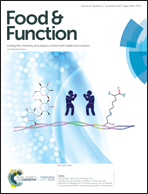Lactoferrin promotes bile acid metabolism and reduces hepatic cholesterol deposition by inhibiting the farnesoid X receptor (FXR)-mediated enterohepatic axis†
Abstract
Background: Lactoferrin (LF) is a multifunctional glycoprotein that can regulate lipid metabolism, lower cholesterol, reduce body weight, and prevent atherosclerosis. Bile acid (BA) metabolism plays an important role in removing excess cholesterol from the body. However, studies on the effects of LF on BA metabolism are limited and inconsistent. Methods: Male C57BL/6J mice aged 6–8 weeks were fed with a normal diet (control group), high-fat/high-cholesterol diet containing cholate (HFCCD group), or HFCCD and 1.0% LF in drinking water (LF group) for 8 weeks. Serum and hepatic lipid profiles, and glucose tolerance were measured. Fecal BA composition was determined through ultra-high performance liquid chromatography–tandem mass spectrometry. The gene expression of BA synthase in the liver and farnesoid X receptor (FXR)-mediated BA negative feedback regulation pathway in the liver and ileum were analyzed via RNA analysis. Results: HFCCD resulted in abnormal cholesterol levels in the serum and liver. LF intervention significantly increased the serum high-density lipoprotein cholesterol level by 24.9% and decreased the hepatic total cholesterol content by 26%. LF treatment significantly increased the BA content per gram by 109.8%, the total amount of BA excretion by 153.5% and conjugated BAs by 87.6% in the feces. Furthermore, LF upregulated the expression of the hepatic sterol 12α-hydroxylase (CYP8B1) gene, which expresses important enzymes in the classical pathway of BA synthesis, and the bile acid-CoA amino acid N-acetyltransferase (BAAT) gene, which is responsible for the formation of conjugated BAs. The FXR-mediated pathways in the enterohepatic axis, including FXR, fibroblast growth factor 15, and fibroblast growth factor receptor 4, were inhibited by LF. Conclusions: LF ameliorated hepatic cholesterol deposition in mice fed with a high-fat and high cholesterol diet containing cholate. LF elevated the conjugated BA level, inhibited the ileum FXR and FXR-mediated enterohepatic axis, and increased BA synthesis and excretion.



 Please wait while we load your content...
Please wait while we load your content...